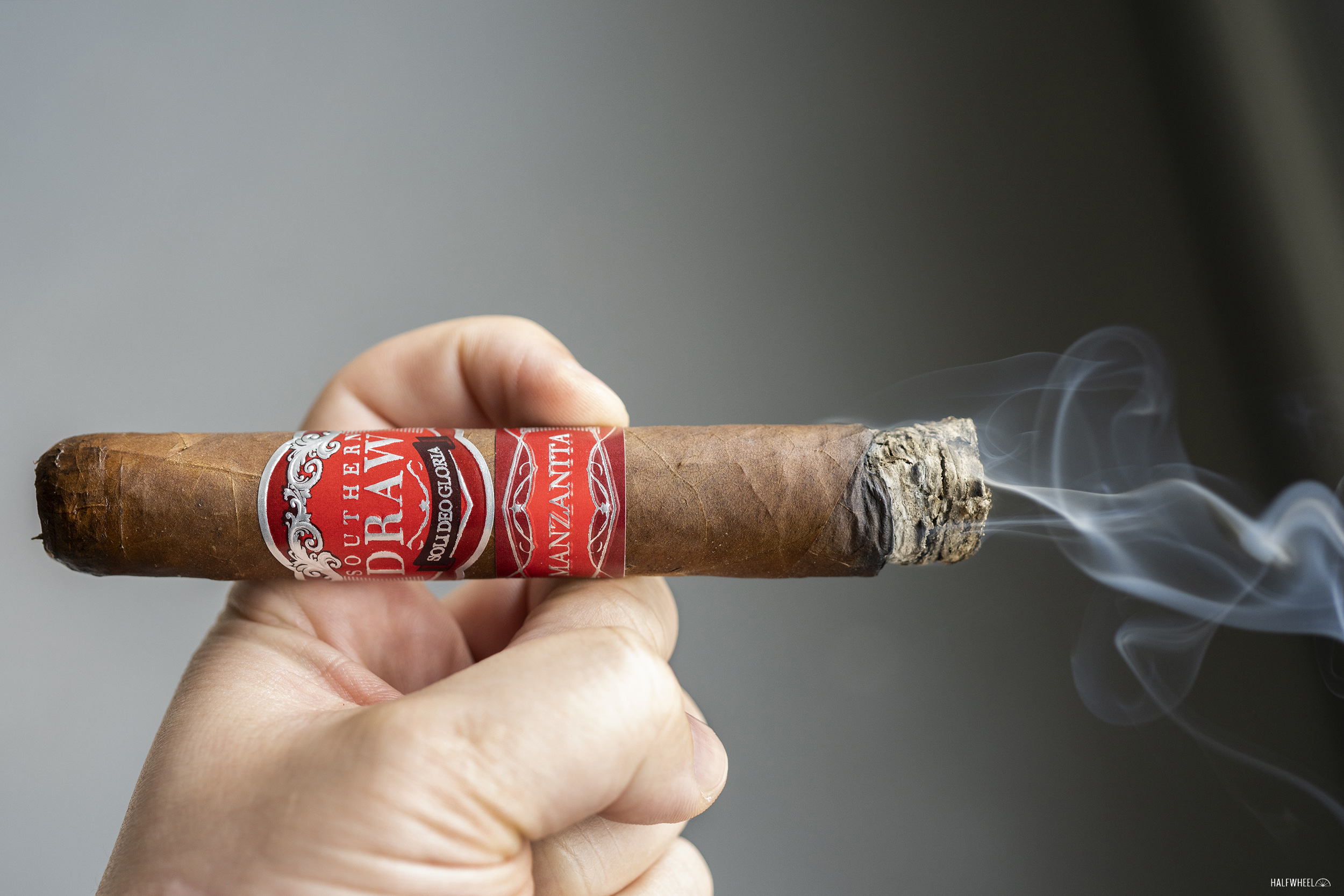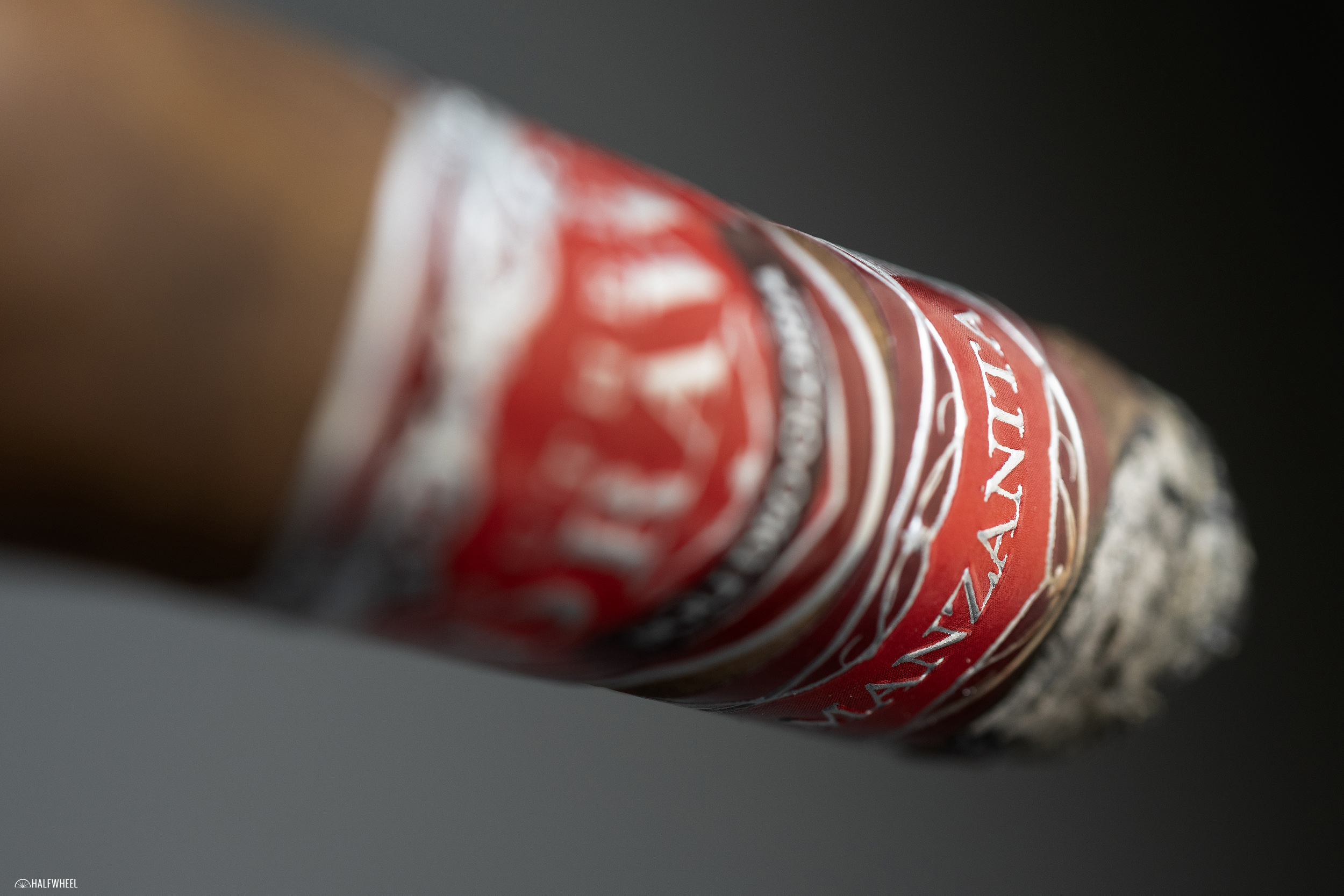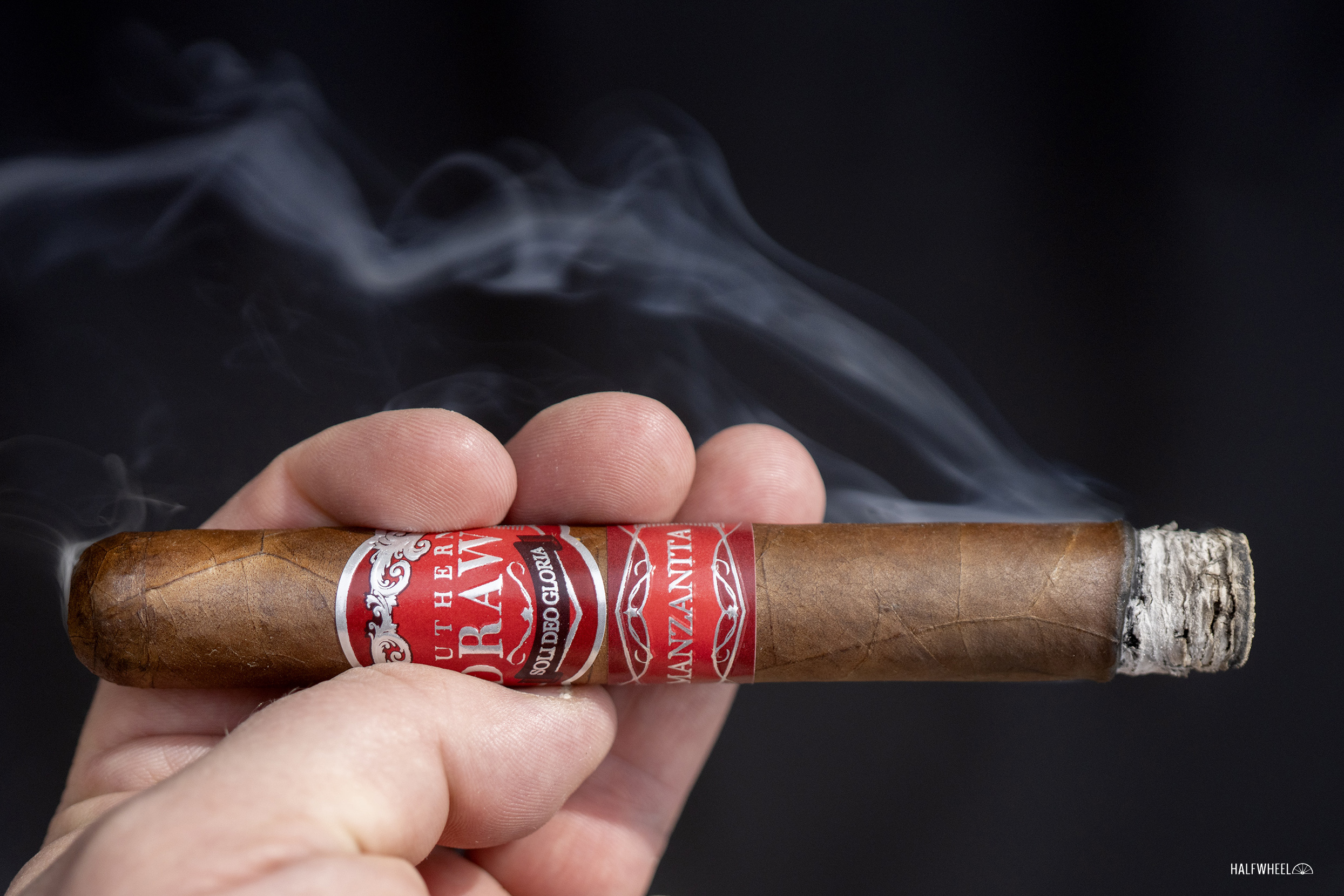In late 2020, Southern Draw Cigars released a new line called Manzanita, which the company said was made to pay tribute to the history of tobacco.
It was a bit of a different release for Southern Draw for a number of reasons. First, for a company that I think of as usually providing a great value for consumers, the cigar has an MSRP of $14.99, which is at the top end of Southern Draw’s pricelist. Secondly, the company decided not to disclose the countries where the tobaccos came from.
That being said, it did disclose that it is being made at Tabacalera AJ Fernandez Cigars de Nicaragua S.A., and the company also disclosed the varietals of tobaccos it is using. The wrapper is a hybrid habano leaf, the binder is habano and the filler contains corojo 99, ligero and pelo de oro. Admittedly, the filler description could be somewhat confusing as “ligero” is not a seed varietal, meaning that the corojo 99 and pelo de oro tobaccos could also be “ligero” primings.
“We have long desired to share the history of traditional tobacco and its spiritual importance and then we had an epiphany while working on names for our new cigar release,” said Robert Holt, founder of Southern Draw, in a press release. “Some nostalgic names were thrown around, but, when we saw this leaf, its deep red color, observed the texture, rolled the tabaquiados and smoked them together, there was a unanimous endorsement that Manzanita, meaning ‘little apple’ in Spanish, describing the tiny, apple-like fruit, was perfect.”
While only one size was released at first, the company made it clear that there would be a robusto and gordo added in 2021. In late May, those two new sizes began shipping to stores, bringing the number of Manzanitas to three.
- Southern Draw Manzanita Robusto (5 1/2 x 54) — $13.99 (Box of 10, $139.90)
- Southern Draw Manzanita Toro (6 x 52) — $14.99 (Box of 10, $149.90)
- Southern Draw Manzanita Gordo (6 1/2 x 60) — $15.49 (Box of 10, $154.90)
Unlike most companies, Southern Draw is quite forthcoming about how many cigars it intends to make. For Manzanita, it’s up to 75,000 cigars per size each year, which is more than the 60,000 per year the company originally announced.
Also keeping with another part of Southern Draw’s identity, a portion of the sales of Manzanita are being donated. This time it’s going to First Nations Development Institute, an organization that works to improve economic conditions in Native American communities. Southern Draw previously said it hoped to donate $30,000 to the group’s Nourishing Native Foods & Health.
- Cigar Reviewed: Southern Draw Manzanita Robusto
- Country of Origin: Nicaragua
- Factory: Tabacalera AJ Fernandez Cigars de Nicaragua S.A.
- Wrapper: Undisclosed (Hybrid Habano)
- Binder: Undisclosed (Habano)
- Filler: Undisclosed (Corojo 99, Ligero, Pelo de Oro)
- Length: 5 1/2 Inches
- Ring Gauge: 54
- Vitola: Robusto Extra
- MSRP: $13.99 (Box of 10, $139.90)
- Release Date: May 2021
- Number of Cigars Released: Regular Production
- Number of Cigars Smoked For Review: 3
The first thing I notice about the Southern Draw Manzanita is the printing on the bands, which isn’t as clean as most cigars. Fortunately, this isn’t a blog about cigar packaging design—at least not today—so my attention turns to the dark wrapper, which has quite a bit of red hues and some obvious veins. The aroma from the wrapper is medium-full, though I don’t get much in the way of individual flavors. I pick up some barnyard, redwood flavors and something that reminds me of hand soap. The foot is sweeter thanks to a big chocolate sensation that sits on top of cedar, creaminess and woods. The cold draw has a mixture of pineapple, chocolate and leather, though the pineapple flavor seems a bit stronger than the other two.
Upon lighting—particularly the first cigar—I’m a bit surprised by how little smoke hits the palate. Flavor-wise, I find leather, peppermint and some acidity, though I need more smoke to really get a full picture. On the subsequent two cigars, I taste those flavors along with some more woody flavors. All three cigars seem to take a few puffs before the flavors really begin to coat my palate. Once the cigar has hit its stride, a clean profile emerges with earthiness leading a bitter peanut butter, fruity sweetness and some minerals. On one sample, I find the fruitiness to be close to an artificial grapefruit. While the earthiness emerges pretty quick, the other flavors seem to find their grooves once the first inch-long clump of ash falls. Retrohales are also led by earth, though a bread flavor makes a decent charge to challenge the top spot. There’s some chocolate on two cigars, though it disappears before the end of the first third. While I found the main profile to be very clean, there’s a noticeable uptick in grittiness as the retrohales finish. It’s still led by earth, though a not-so-sweet creaminess is now the secondary flavor. Flavor is nearly full, body is full and strength is inconsistent. Some puffs I can feel the nicotine, but most of them I can’t. What’s quite clear is that the percentage of puffs where I can feel the strength is increasing as the cigar as the cigar burns, though I’d still peg the first third around medium-plus. All three cigars require me to use the lighter almost immediately after lighting—something I don’t dock the cigar points for—and two of the cigars have slightly tight draws, though construction is otherwise impressive.
By the midpoint of each cigar, the flavor is remarkably consistent, though the strength levels are all over the place. The first sample is solidly medium-full, continuing the aforementioned trend of having some puffs with noticeable nicotine and others without it. The second sample is more medium and I don’t really have concerns about the cigar getting too strong. On the third sample, I’m concerned because the strength is pretty much full and I know what’s coming next. Flavor-wise, earthiness remains the main flavor, though it’s now joined by a metallic flavor. Fortunately, it’s not a harsh metallic flavor and actually does well to accent the earthiness. If I could draft flavor notes, metallic wouldn’t be a first-round selection, but it helps to provide a new dimension to the earthiness and never lead to a burnt harshness, so I’m content with how it works here. At times, there’s more of that not-so-sweet creaminess, which also works to add new dimensions to what is otherwise a lot of earthiness. The finish has an uptick in mineral-like flavors and something that reminds me of subtle potato notes I find in some vodka. At times, there’s some creaminess and lemon, though neither are consistent. Retrohaling continues to show earthiness, though it’s a bit tastier thanks to some roasted flavors and something that reminds me of a mark. The finish of the retrohale has more of the mineral and metallic flavors and a faint hint of pepper. Flavor is nearly full and body is full. One cigar needs a touch-up to help with smoke output, though the burn line and ash formation are excellent.
If you are hoping to find out that the Southern Draw Manzanita Robusto has a different main flavor, you are going to be disappointed. While it’s changed a bit, earthiness is still the clear frontrunner of the profile. There’s more toastiness—different than the second third’s retrohale—minerals, creaminess and something that reminds me of sunflower seeds. The finish is creamier, though still mostly a mixture of earthiness and minerals. Retrohaling produces earthiness over barnyard and an increased amount of black pepper, though it’s still quite mild. The finish has earthiness and minerals over some sour creaminess. Flavor is still right on the edge of being full, body is medium-full and the strength is at varying levels of full. The first cigar is providing enough nicotine that I know I will immediately be consuming some candy afterward to help counteract my lightheadedness, the second cigar gets smoked down to about an inch left and I can just feel my head getting light, the third cigar—which had been stronger in the second third—is somewhere in the middle. Each cigar needs a touch-up to help with smoke production, which isn’t surprising given the strength of the cigar.
Final Notes
- The way I write these reviews is to avoid finding out any information until after I am done smoking the cigars and writing the tasting notes, i.e. the four paragraphs you see above. For this review, I wrote everything other than this bullet point and the background information paragraphs—i.e. the very top part of the review—until after I was done with everything else. So I was stunned to read Brooks’ review of the Manzanita Toro, where he found the cigar to be neither dominated by earthiness, nor that strong. If you are wondering about the discrepancy, I suspect that it has more to do with the difference in cigars we smoked than our own abilities to write about the experiences we had. Brooks and I aren’t lockstep in agreement for every detail of every cigar, but we also aren’t this far off.
- My memory of cigars isn’t great, so I imagine in three months I won’t remember this for being dominated by earth but I will remember this as the strongest Southern Draw I’ve smoked.
- Strength-wise, this is about where my limit is. Because of the nature of reviewing cigars, I have to smoke cigars of all levels of strength, including ones that repetitively cause me problems. I’d feel comfortable smoking a cigar with this amount of strength at a lounge or after dinner one night, but I don’t think I’d want to smoke a cigar any stronger.
- After the first cigar, I adjusted my sugar intake earlier in the day knowing that I was going to smoke an abnormally strong cigar next. To put some context about how strong this cigar is, I probably do this for one or two reviews per year. I’ve long believed that a cigar’s strength hits people differently, so perhaps the Manzanita is an Achilles heel for me.
- Two of the three cigars I smoked had slightly tight draws. As someone that generally likes a tighter draw, this was perfectly fine for me, though I imagine many cigar smokers will probably want it to be looser.
- Previously, the Southern Draw Jacobs Ladder Brimstone would have been my nomination for strongest cigar in the Southern Draw profile. After smoking the Manzanita Robusto, the Brimstone is now the second strongest cigar and I don’t think it’s quite close between first and second.
- Nicotine strength and pepper are oftentimes confused when describing cigars, but this is a classic example that just because a cigar is strong doesn’t mean it’s going to have a lot of pepper in the profile. My last review was of a Connecticut shade-wrapped lonsdale that had magnitudes more pepper and probably less than a quarter of the nicotine compared to the Manzanita Robusto.
- Flavor-wise, our reviewers—myself included—have lauded complex cigars that were dominated by earthiness, particularly Honduran puros and cigars that use Mexican San Andrés wrappers. The difference between those cigars and the earthiness I got from the Manzanita is the layered earthy sensations compared to a singular earthy sensation that gets accented by other flavors. The latter is what was at play here and it created a pretty monotonous flavor profile.
- I always find it interesting when people decide to declare Cuban cigars they see on the internet fake based on a 500-pixel wide picture where the alleged telltale sign is that the printing is slightly sloppier than normal. If a Cuban cigar band was printed in the same quality as this band, I suspect there’d be a lot of people claiming it to be fake. Each cigar had issues with the silver text, particularly the “SOLI DEO GLORIA” part on the main band. The “MANZANITA” text has a shadow-like quality below it that is very visible. Printing bands is not something I know anything about, but mistakes happen and many cigars would fail to pass the same scrutiny that the sleuths on the internet apply to Cuban cigars.
- Furthermore, I’d venture to guess that 99 percent of people who smoke this cigar will never realize these relatively small printing issues.
- In Nicaragua, the size of tobacco fields are often measured using a term called manzanas, which translates to apple. It’s a weird name for a measurement, though it equates to about 1.75 acres per manzana.
- Cigars for this review were purchased by halfwheel.
- Final smoking time is just under three hours on average.
- Site sponsors Atlantic Cigar Co., Corona Cigar Co. and Famous Smoke Shop all carry the Southern Draw Manzinata Robusto.
The most common question to determine if a cigar is worth its price is does the cigar’s flavor and/or length of smoking time justify the price? We don’t factor price into our scores and we also don’t factor nicotine strength into any of our scoring metrics. But for me the question with the Southern Draw Manzanita is does this cigar’s flavor justify its strength? The answer is no. While neither linear nor one note, this cigar provides an earth-dominated profile that doesn’t stand out from so many other earth-heavy cigars except for the fact that midway through two samples I was questioning whether I was going to need to lie down after finishing the cigar. If you want a nicotine bomb, this is a great option. But Southern Draw makes plenty of cigars that are not only more approachable but far better flavor-wise.








